Exploring Syria
The history of the Middle East is visible everywhere
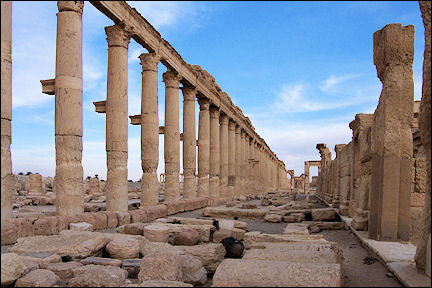
|
The Middle East, at the crossroads of ancient trade routes, has a long and eventful history. The oldest civilizations in the world, biblical history, the crusades, the influences of Egypt, Greek, Roman and Arabic cultures. There are remains of almost all of this in Syria: in Damascus, Krak des Chevaliers, Hama, St. Simeon monastery, Aleppo and Palmyra.
Travelogue & photos: Johan Siegers
Damascus
One of the oldest still inhabited cities in the world
Our trip in Syria begins in the capital Damascus, a city with a long history. It is one of the oldest still inhabited cities in the world: people have lived here since 2,500 BC. Excavations in Tell Ramad, at the edge of the city, even indicate that people lived here since 8 - 10,000 BC.
Damascus became a city of importance only after the arrival, in the 9th century BC, of Aramaics, who where Semite nomads, from Mesapotamia. One ruler followed after another. The Assyrians conquered and destroyed the city in 732 BC, in 572 BC followed by the Babylonians and in 538 by the Persians. After the conquest by Alexander the Great in 332 BC, Damascus came under Hellenist rule. In 64 BC the Romans took the western part of the city.
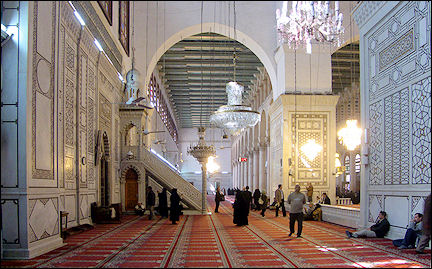
|
After the birth of Islam in 634, Damascus became the seat of the Umayyad dynasty and one of the most important cities in the Middle East. Damascus was conquered and looted by different attackers in later times as well./p>
Only after the second world war, when Syria became independent, Damascus became the capital of Syria.
As a first introduction to the city with its turbulent history we take a short walk to some of the highlights, like the souk and the Umayyad mosque. This mosque, which is also called Great Mosque of Damascus, is one of the largest I have ever seen. Its outside walls are 100 and 157.5 meters long. The women in our group have to wear a kind of monk habits which cover their bodies completely.
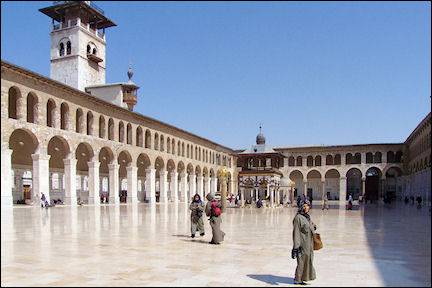
|
The mosque has a large courtyard at the center of several buildings that are painted in Arabic style. Inside the main building is a large prayer hall, with of course a seperate section for women. Another building contains the remains of Saladin, who was sultan of Syria and Egypt and fought against the third crusade (1189-1192).
The souk is like a mall, with many small, specialized stores. Clothes, gold, candy and spices: you can find everything there. It is still used by the locals to shop.
The Azem palace is near the souk. It's a perfect location for a short visit.
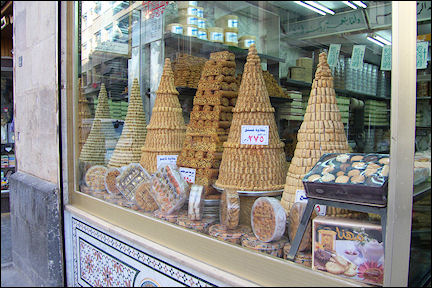
|
The streets of the souk are such a maze that we get lost. The locals feel honored when they hear we want to visit the palace and they give us directions. One of them even accompanies us, to keep us from getting lost again.
The Azem Palace was built in 1750 as a residence of the Ottoman governor. Nowadays the traditional building houses a museum of art and cultural traditions.
Krak des Chevaliers (Qal'at al-Hosn)
A huge crusaders castle on a 650 meters high hill
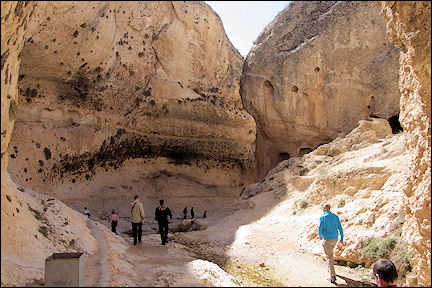
|
We drive northward to the crusaders fortress Krak des Chevaliers with to our left the Anti Lebanon mounains. Behind those mountains lies Lebanon.
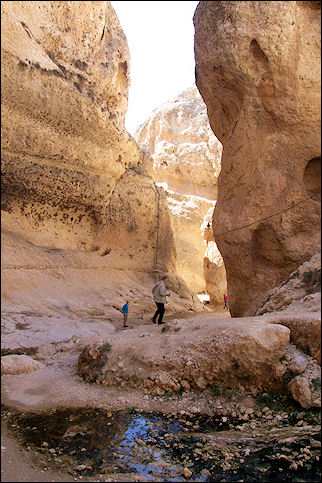
|
At Maluua we take a walk through a gorge to a little church. It has beautiful frescoes, which we are not allowed to take pictures of, unfortunately.
We are welcomed in Aramaic, which probably is the language Jesus and the apostles spoke, a language than is only used by few nowadays.
As we get nearer to Krak des Chevaliers, the landscape gets greener. The trees have grown crooked because of the wind. There's a pasture with Dutch cows.
The weather has deteriorated. The sun is hiding and some dark clouds are coming our way.
The crusaders castle sits on a 650 meters high hill. The word "krak" comes from the Syrian karak, which means fortress. Because of its strategic location, it controlled the road inland as well as the road to the north.
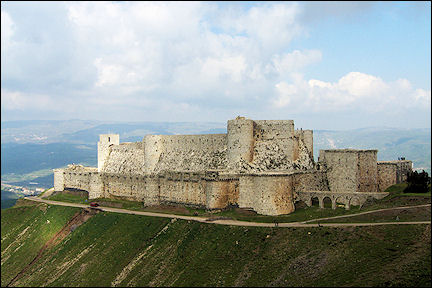
|
The original castle on this spot was probably built in 1031 for the Emir of Aleppo. It was conquered in 1099 by Raymond IV of Toulouse during the first crusade, who immediately afterwards abandoned it.
In 1142 it was taken by the Hospital Order of Knights, also known as the Maltezer Order. They extended the castle with a three meters thick outer wall with seven towers.
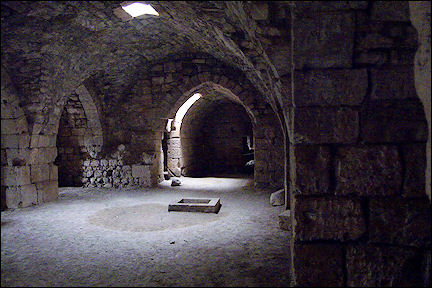
|
After the reinforcement several attempts were made in vain to conquer the castle. Only in 1271 the Mamluks succeeded with help of large catapults. Jerusalem was already taken and the castle was one of the last vestiges of Christian power in the region.
The castle was defended by 200 troops instead of the 2,000 that could be housed there. Eventually the crusaders surrendered, after negotiating a safe retreat to Tripoli.
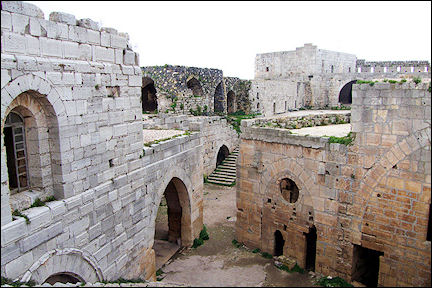
|
In 2006 Krak des Chevaliers was made Unesco World Heritage, together with the citadel of Qal'at Salah El-Din. There is a lot to see in the castle, so bringing a floorplan or a guide is a good idea. It has huge horse stables and a gigantic kitchen. Everything is there to feed and house an army of 2,000.
Hama
Large wooden waterwheels scooped water from the river
A little before dusk we arrive in Hama, much farther north. Hama is mostly known for its historic town center Hamath (fortress). Excavations show that this place was already inhabited between 8,500 and 1,000 BC and that there was a strong Egyptian influence. From 835 BC Hama was controlled by the Assyrians. The town has a turbulent past with many battles and even destruction by an earthquake. Hama is part of Syria since 1941.
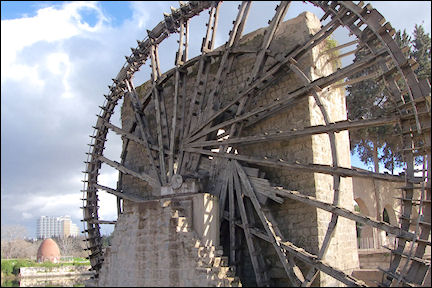
|
It's already too dark to take pictures of the norias (large waterwheels), even though they are illuminated at night. Fortunately I have some time the next day to go back and take pictures in daylight.
Workers are busy restoring the wheels. Large pieces of wood are brought in. In the past the wheels were used to scoop water from the Orontes river into the higher lying aquaduct. Nowadays they are only an important tourist attraction.
St.Simeon monastery (Qala'at Samaan)
Simeon Stylites sat here on ever taller pillars
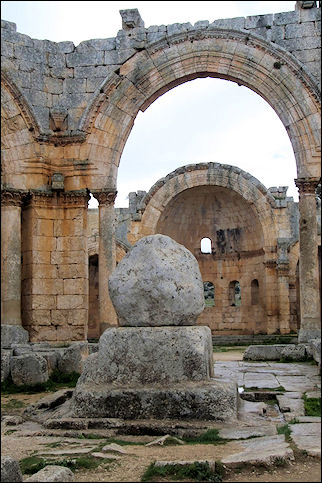
|
On our way to the St.Simeon monastery the good weather abandons us completely. It's a pity, but it can happen in March, especially in a fertile region like this. On the upside, it's nice and quiet at the ruins of the monastery. The local population doesn't visit here when it rains.
The St.Simeon monastery, 30 kilometers from Aleppo, was named after Simeon Stylites (389-459). Simeon, son of a shepherd, joined the monastery when he was 16 years old.
But the monastery was not ascetic enough for him. He wanted to fast for long periods of time. This was against the rules of the monastery and he was forced to leave.
Simeon found a deserted spot in a cave in a deep gorge. Trying to increase his virtuousness, he decided to fast - according to legend - for 40 days. It almost killed him. Bassus, the leader of the monks, eventually brought him water (and later also food) and Simeon recuperated.
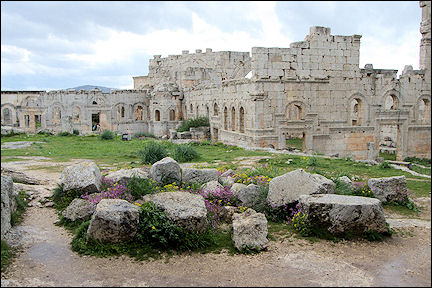
|
This deed of piousness became known and people started to visit him to get his blessings. Apparently Simeon disliked this invasion so much that he retreated on a 3 meters high pillar, so people couldn't touch him. Over the years, he retreated to taller and taller pillars.
After his death a pilgrims church was built around the pillar. Since the arrival of Islam in the region the monastery hasn't been in use and it became dilapidated.
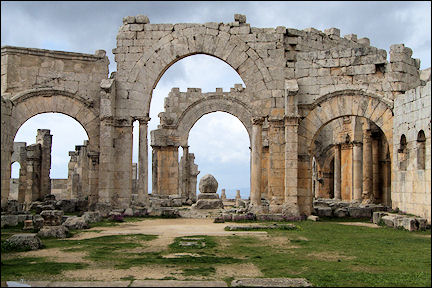
|
The monastery was expanded in several phases around Simeon's pillar, into the shape of a cross measuring 80 by 100 meters. There isn't much left of the tall pillar, also because pilgrims chop of little pieces every time they visit.
After wandering for an hour in and around the monastery, it's time for a picnic, which takes place inside because of the rain. We are served mezze, which actually are hors d'oeuvres: olives, bread, pickles, humus and salads. More than enough and also very tasty.
Aleppo (Halab)
The old citadel towers over the modern city
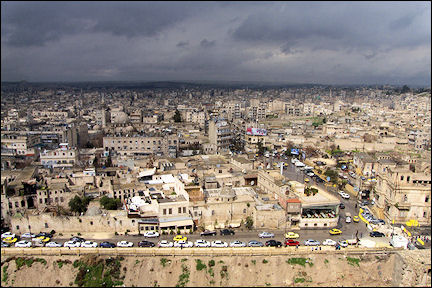
|
It rains almost all the way to Aleppo in the north-west of Syria. In Aleppo, Syria's second city, history is tangible. Like Damascus, it is one of the oldest still inhabited cities in the world, it is supposed to have existed since 5,000 BC.
Because of its location at a strategic spot between the Mediterranean and the Euphrates, at the crossroads of two trade routes, Aleppo has always been an important commercial city. Aleppo (not Istanbul) was the final destination of the famous Orient Express. Nowadays Aleppo has over 2 million inhabitants.
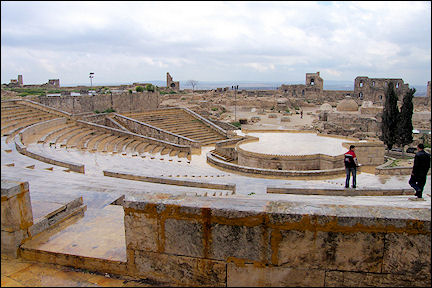
|
The city was destroyed by the Persians in 611 and another time by an earthquake in the 10th century. In 1260 and 1401 the population was driven away by the Mongols. Under Turkish rule the city prospered again until 60 per cent of the population was killed in an earthquake in 1822.
Aleppo is a perfect city just to wander around in. The old city is not damaged by modernization. Old building have been preserved, so it's easy to imagine what it looked like in the past.
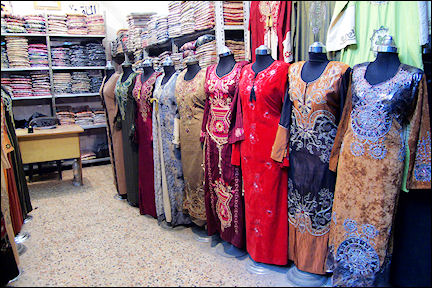
|
Aleppo has a wonderful and very busy souk. In some of the stores we see photos of the Dutch royal family. Did they put them there when they heard a group of Dutch tourists was visiting? They try very hard to sell their merchandise to tourists and the first thing they offer is a kaffyia.
Meanwhile it is raining again, but large parts of the souk are covered, so it doesn't matter. Until we leave the covered area. It rains two days a month on average in this region and we got both days. When we walk up the stairs to the citadel, water is streaming towards us. This citadel is supposed to be bigger and more beautiful than the one in Damascus, but because the latter was closed, I can't vouch for that.
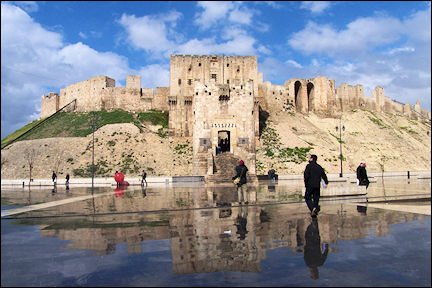
|
After our visit to the citadel, part of our group visit the national museum. It has artefacts that were found at excavations, varying from an almost complete Neanderthal child skeleton to vazes, jugs and jewelry.
In the evening there is a performance by twirling dervishes. It is a private show for our group and that shows in the price of the tickets. I decline and hear later that it was disappointing. No twirling to a higher state of consciousness; a short demonstration and that was it.
Palmyra (Tadmor)
Palmyra has been an important city since antiquity
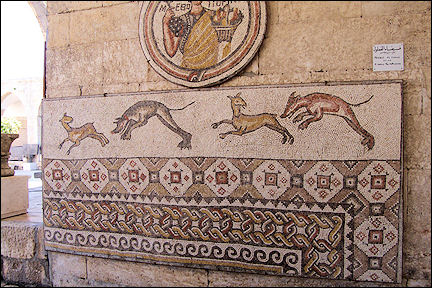
|
When we drive to Palmyra the next day, the sun is fortunately shining again. We stop to visit a mosaics museum, which mainly has ancient floors. Some are as big as 4 by 8 meters.
It must have been a lot of work to lay in stone after stone. Nowadays the cost of mosaics this size would be prohibitive.
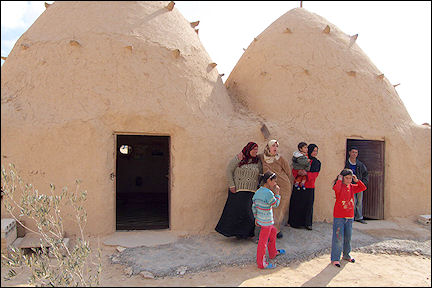
|
We stop a second time to visit so-called beehive houses. They look like egg halves. The walls keep out the heat in the summer and the cold in the winter. Still the apartments seem primitive to live in.
We get a first look at the old city of Palmyra from the high- lying 16th century Arabian fort Qalat Ibn Maan. We have a great view of the ruins here.
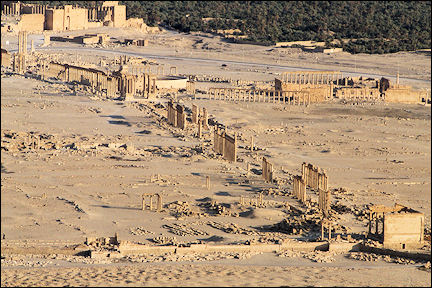
|
Palmyra has been an important city since antiquity. Located in an oasis between Damascus and the Euphrates in the Syrian desert, it was an important stopping place for caravans crossing the desert. It also was an important link in the silk route from China and India to Europe.
In 41 BC the Romans tried to conquer the city. They failed because the population fled to the other side of the Euphrates, taking everything of value with them. They could do this because they still lived mostly as nomads. The abandoned city was annexed by the Romans, though.
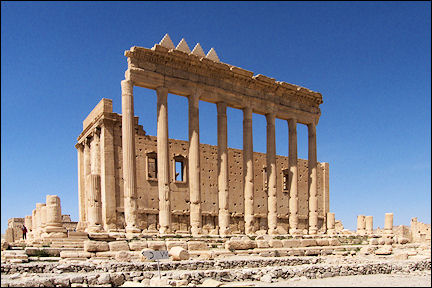
|
The most glorious era followed after Queen Zenobia came to power in 267. She declared independence from Rome and fought the Romans all the way to Egypt. She was eventually defeated in 272 and mighty Palmyra was destroyed. The city was built up again under Emperor Diocletianus.
In 634 Palmyra was conquered by Arab Muslims who left the city standing. It became an Arabian settlement. In 800 most people left the city after a civil war.
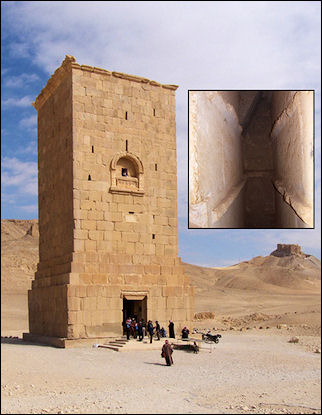
|
The city became dilapidated under Ottoman rule. Only in the 17th century it was rediscovered by travelers.
The next day we visit the ruins. First some tombs, both in towers and underground. The dead were stripped of their entrails and organs, wrapped in sheets and shoved into narrow niches. Afterwards the tomb was sealed with a bust.
The old city is extremely beautiful. Mostly fallen to ruins, but very impressive. Some buildings have remained more or less intact. One of the most important buildings is a gigantic Ba'al temple.
Ba'al is a general title of honor and means "lord"; it was used for different gods. Ba'al is often mentioned in the Bible. The followers of Ba'al were enemies of the God of the Israelites and vice versa.
The next day we drive to Jordan via Damascus. It's very busy at the border. Long lines of cars are waiting for extensive checks.
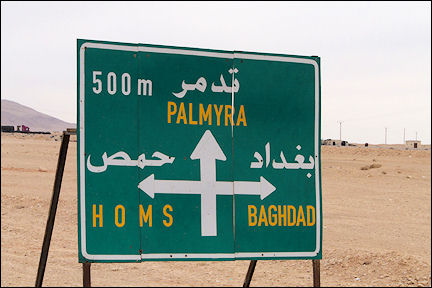
|
Prices in Jordan are twice as high as in Syria, that is why people are willing to wait for two days to be able to go shopping in Syria and go back with their cars loaded to capacity. There are restrictions for some goods, and therefore every car is searched.
We are lucky with our tourist coach. We can pass everyone else and go to passport control immediately. The coach is not allowed to cross the border. We have to walk with our luggage to a similar coach that is waiting for us in Jordan. All our luggage is scanned.